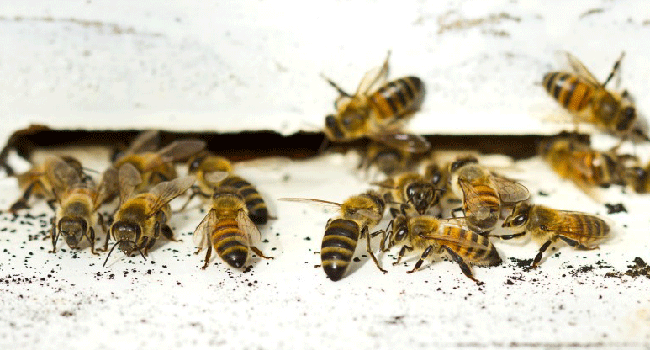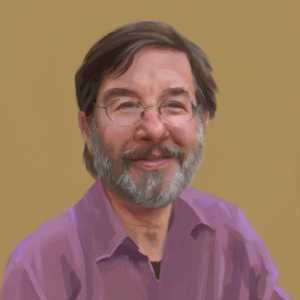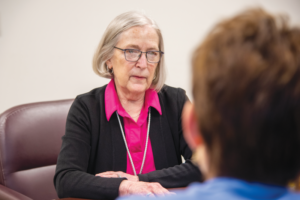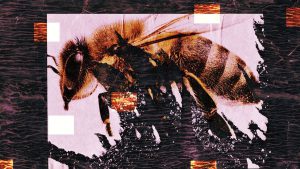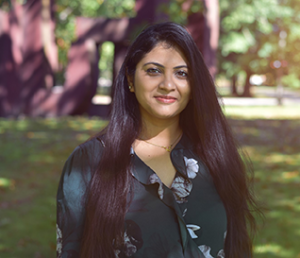By Ross Conrad
Annual Interview Section
The names Jim and Maryann Frazier are very familiar in beekeeping circles. The scientific duo has been in the forefront of research into bees and pesticide’s effects on these magnificent pollinators. Maryann and Jim were gracious enough to take time out of their busy schedules to answer some questions that I had for them.
The first question I had was a common one we beekeepers tend to ask each other:
How did you get into beekeeping?
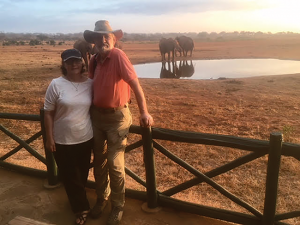
Jim and Maryann in Kenya where honey bees are thriving despite the presence of Varroa mites thanks in part to their work with local beekeepers there.
Maryann: “The year I graduated from high school I was accepted into a youth conservation camp. One of the camp counselors had bees. At breakfast one morning she was excited and told me that one of her hives at home had swarmed and her fast-thinking brother caught the swarm in an old record player case and hived it! I was shocked! Why would anyone do such a (dangerous) thing? For the next hour I questioned her about honey bees. The things she told (bees can make new queens from workers, they can dance to communicate, they reproduced by swarming, etc., etc.), I was certain could not be true. I remember distinctly leaving that conversation telling myself that one day I’d have the chance to learn more about honey bees and when it comes along, I’d take the opportunity. That opportunity came two years later when I meet the technician of Dr. Al Benton. Benton was the honey bee researcher at Penn State where I was working on my undergraduate degree – he also taught a course in beekeeping. I took the course in my junior year and fell in love with honey bees. After teaching Ag Education for six months as a permanent substitute, my good friend and graduate student working on his PhD, Andreas Thrasyvoulou, talked me into coming back to PSU to work on a masters degree in Entomology specializing in apiculture. My advisor, Dr. Benton told me I could get the degree but that I should not expect to work in the field because I was a woman and there were no jobs. But I was very lucky and have never NOT worked in the field of apiculture. My first job was as the assistant state apiary inspectors in MD and then I landed a job as a beekeeping specialist – in Sudan.”
Jim: “As a scientist interested in chemical ecology and insect behavior since the early 70s, honey bees have always had a special place in my heart. This originally began with my graduate course in Behavioral Genetics at Ohio State taught by Walter Rothenbuehler, where honey bees were a large part of our reading and discussion.
There is such an extensive scientific literature on them and yet there are also so many unanswered questions that the intrigue of generating new understanding as a researcher finds honey bees a quintessential target, it was during the CCD eruption of 2007 that Maryann first got involved and our hour-long commute to PSU campus daily each way gave us ample time to discuss things. My incessant ‘why are you doing that’ and ‘why aren’t you doing this’ comments to Maryann finally prompted her to say ‘well why don’t you get involved!’. As any good husband would do, I followed by volunteering and joined Maryann and Chris Mullen as a team that quickly focused on pesticide impacts on bees.”
How did you end up working at Penn State?
MF: “After completing my 2½ years as a beekeeping specialist in Sudan in 1989, I decided I wanted to continue to work in international development with honey bees. I came back to the U.S. and started my search for another overseas job. In the meantime Dr. Clarence Collison, who was the honey bee extension specialist at Penn State, asked me to come and work for him. Varroa had just arrived in PA. I agreed but made it clear that I would be leaving as soon as I could find another development job. We wrote a grant to study Varroa that got funded. Then Clarence left Penn State to become the department head at Mississippi State. Two things kept me at Penn State; I had the opportunity to teach the course that turned me on to beekeeping (and did so in one form or another for the next 26 years) and in 1992 Jim proposed. We were married the following year and this year celebrated our 25 anniversary.”
JF: “I knew Charlie Pitts, the former head of Entomology quite well through our mutual interests in insect chemoreception. He called at DuPont and asked if I might be interested in looking at Penn State as the new head of the department. He said knowing me and knowing the people there, he thought I might find it interesting. I went and discovered a collegial group of entomologists and within a few months transferred there from DuPont as department head. It was a most interesting choice for me as a senior scientist at DuPont, I could have stayed and gone into management, and probably spent the remainder of my career there, but I felt that I had a much broader understanding of Entomology as a science that was not being used there, but could find impact as a department head. I found the following 10 years both challenging and rewarding as we merged my industrial experiences with academic challenges to transform the departments programs.”
How did you two meet?
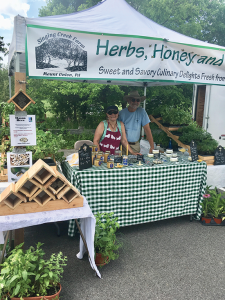
The Fraziers have “retired” to their farm and can be found staffing their booth at the farmer’s market in Mount Union located about an hour south of State College, Pennsylvania where the two worked for years studying honey bees.
MF: “At Penn State in the Department of Entomology – Jim came into the department as the department head shortly after I did. Essentially I married the boss!”
JF: “Maryann kept trying to fix me up with her sister, so I asked Maryann out to find out more and the rest is history.”
How long have you been working with bees?
MF: “35 years !!! How is that even possible!”
JF: “As I indicated it was the 2007 period of CCD emergence that I began to focus on honey bees as a new bee scientist. I knew the scientific literature on bees was extensive, but never really appreciated how extensive, until I began immersing myself in it looking for where the current level of understanding was about pesticides impacting bees. One really interesting revelation was that the insect toxicology literature had always focused on how one achieves the field exposure to a dose that will kill greater than 95% of the target pest insect, with very little fundamental knowledge of how a dose less than that might impact the physiology and behavior of the target pest, or even of non-target pests that might get some incidental exposure. In the case of systemic pesticides like neonicotinoids the transport from treated seeds into the plant always results in concentrations in nectar and pollen of the plant that are below highly toxic levels, but can have multiple kinds of sub-lethal impacts. This was an area for which practically no data existed and one that we have been focusing on, as has the bee research community, in the last 10 years.
What is the most interesting thing you’ve discovered about pollinators/bees?
MF: “How much stress honey bees can tolerate.”
JF: “The myriad sub-lethal impacts of pesticides on bees of all kinds has emerged as a major focus of relatively recent bee research. A good summary of this can be found in the IUCN report of the Worldwide Integrated Assessment of Systemic Pesticides (http://www.tfsp.info/assets/WIA_2015.pdf). The other thing was from a farmer funded project that Maryann and I did on native pollinators on red raspberries on our farm and two other organic farms. We found to our surprise that the commercial production of red raspberries had evolved to cut the first flush of canes and force the plants to regrow so that once they started to fruit, this would continue until frost. That shifted the blooming period after the flush of native bees we found on our wild red raspberries, and inadvertent consequence of an agronomic practice adopted for market concerns, but without the input of critical pollination biology.”
What was the most challenging study you participated in and why?
MF: “Everything we have done related to pesticides. Because honey bees colonies are so variable and resilient, working on the impacts (especially sub lethal) of pesticides in field studies, was very challenging; trying to have enough replication, keeping colonies alive long enough to see effects, and separating the effects of the pesticides from other factors such as Varroa, viruses and environmental issues was very difficult and frustrating.”
JF: “We really began without any knowledge of how much pesticide bees were actually being exposed to and how much they returned to the hive. We were the first group to have a wide range of bees and hive matrices samples analyzed for pesticides and these levels greatly exceed our expectations for the quantity and frequency with which they were found. It took us several years of field season research to develop a protocol that would allow us to generate a cause and effect consequence for bee colonies of known pesticide exposures.”
What was the most rewarding study you participated in and why?
MF: “The most important study was our (Chris Mullin, Jim and myself along with Sara Ashcraft) 2010 survey of pesticides in hives. I describe it as the best awful work I’ve ever been involved in. It was so disturbing and at the same time so critically important to discover just how much pesticide was accumulating in beehives. The most rewarding work was being on the ground in Kenya and helping the Kenyans come to the realization that Varroa was widespread there. When consulted on what they should do to control varroa I was able to encourage them to do nothing, other than monitor. The honey bees in Kenya now seem to be tolerating Varroa without serious consequences.”
JF: “The study of pesticides in bee hive matrices published in 2010 in an open access journal (https://doi.org/10.1371/journal.pone.0009754) has received more than 90,000 reads and more than 500 citations.”
There has been a lot of media attention on the plight of the honey bee and wild pollinators in recent years. What is your take on this situation?
MF: “There is media attention because people are interested (a chicken-egg thing). I think our generation grew up with honey bees covering the clover that grew freely in our lawns. Who among us has not stepped on and been stung by a bee? The absence of these bees now really resonates with people. Deep down they recognize that something important is missing from our environment and want to know why. It gives us as beekeepers a perfect opening to talk about the importance of pollinators and their plight, especially the over use of pesticides in this country.”
JF: “The multiplicity of factors that are interacting to impact bee population dynamics is a complicated and complex phenomenon that varies over time and location. Individual beekeepers are struggling to keep up, but the research community has generated a plethora of new information on these factors and their interrelationships over the last 10 years. Scientific consensus has begun to emerge as referenced above. Pesticides have gone from the bottom of the list of relative importance to the top of the list for the major factors of pesticides, parasites, diseases, nutrition, and genetics. There is a corresponding, but less extensive scientific literature developing on these impacts on native pollinators as well as the interactions of the pollinator community members on each other and their integrated ecosystem contributions. As this focus continues, we should have a much better basis for making agronomic and policy level decisions about how to sustain their major contributions to our food system and our environment.
What research project(s) are you working on currently?
MF: “Jim and I are now retired and live full time on our lovely farm in Mount Union an hour south of State College. I love being a beekeeper, making honey and selling it at the farmers market. But I am involved in three (citizen science) research projects: PSU land4bees, a project that collects hive data across the state and maps forage to evaluate apiary location quality; a monthly pollen collecting study; and a queen evaluation study to assess Varroa resistance in “Purdue leg chewers” being carried out by the PA Queen Bee Improvement Project. I am also leading beekeeping tours to Kenya! What to come along???”
JF: “I am doing some limited consulting as a bee scientist on legal actions involving beekeepers and pesticide impacts on their operations.”
For more information or to register for a beekeeping tour to Kenya, contact Maryann at MFrazier@psu.edu.






